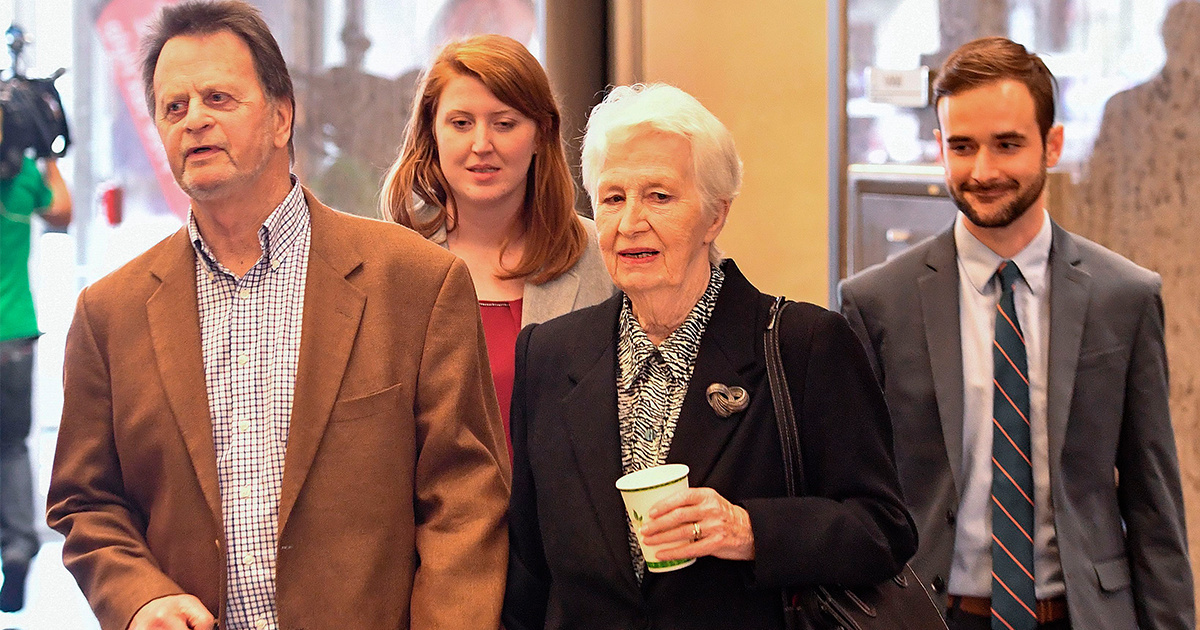
Man Who Developed Cancer After Roundup Use Awarded More Than $80 Million in Damages

Plaintiff Edwin Haderman leaves with his wife Mary after a jury said Monsanto must pay him more than $80 million in damages. JOSH EDELSON / AFP / Getty Images
A jury in the first U.S. federal Roundup trial ruled Wednesday that Bayer must pay more than $80 million in damages to 70-year-old Edwin Hardeman, who developed cancer after using the glyphosate-containing weedkiller to control poison oak, weeds and overgrowth on his Sonoma property for years, the Los Angeles Times reported.
Hardeman’s trial had been split into two parts. In the first, decided last week, the jury ruled that Hardeman’s use of the famous weedkiller, developed by Monsanto in the 1970s, contributed to his non-Hodgkin’s lymphoma. That decision meant the trial could move to the second phase of determining whether Bayer, which acquired Monsanto last year, was liable. The jury decided Wednesday to award Hardeman 0,000 for medical expenses, .6 million in compensatory damages and million in punitive damages, AFP reported.
“Today, the jury resoundingly held Monsanto accountable for its 40 years of corporate malfeasance and sent a message to Monsanto that it needs to change the way it does business,” Hardeman’s attorneys Jennifer Moore and Aimee Wagstaff said in a statement.
Today the jury unanimously held Monsanto accountable for its 40 years of corporate malfeasance, sending a message to Monsanto to change the way it does business, and awarding Edwin Hardeman $80million. @JAMooreKentucky pic.twitter.com/wcT9bjTYXv
— Moore Law Group, PLLC (@MooreLawGroupKY) March 28, 2019
The decision comes a little more than half a year after a jury in a California state case ruled that Roundup use caused a Bay Area groundskeeper’s non-Hodgkin’s lymphoma and awarded him 9 million, though that was later reduced to million and is being appealed. University of Richmond Law Professor Carl Tobias told CNN that Wednesday’s decision shows the first trial “wasn’t a one-off.”
Bayer announced it would appeal Wednesday’s verdict as well in a statement released Wednesday.
“We are disappointed with the jury’s decision, but this verdict does not change the weight of over four decades of extensive science and the conclusions of regulators worldwide that support the safety of our glyphosate-based herbicides and that they are not carcinogenic,” the company said.
Bayer's full statement on the jury's verdict today in California glyphosate multi-district litigation trial to be posted shortly. Link to follow. pic.twitter.com/KhXxfcu9Af
— Bayer U.S. 🇺🇸 (@BayerUS) March 27, 2019
Many regulatory bodies, including the U.S. Environmental Protection Agency, have ruled that glyphosate is safe; however, the World Health Organization’s International Agency for Research on Cancer found it was “probably carcinogenic to humans” in 2015.
In the second part of the trial, Haderman’s lawyers showed evidence that the company had allegedly sought to influence scientists and regulators about the safety of glyphosate, Reuters reported. In awarding damages, the jury found that Roundup’s design was defective, that Monsanto had not warned users of the product’s risk and that it had acted negligently.
Hardeman said he was “overwhelmed” by the ruling.
“It hasn’t sunk in yet,” he told reporters, according to Reuters.
Hardeman’s was the first of more than 760 cases pending before U.S. District Judge Vince Chhabria and was considered a bellwether trial to determine the potential range of damages and settlement options. Chhabria has scheduled another such trial for May and a third will also likely take place this year. All will be split in two parts like Haderman’s trial. The decision to split the trial in two was seen by legal experts as beneficial to Bayer.
There are more than 11,200 Roundup trials pending in the U.S. Another California state trial is scheduled to start March 28, and at least two more should take place in Missouri state court in the fall.
#Glyphosate Exposure Increases #Cancer Risk Up to 41%, Study Finds https://t.co/mKeBRUIrsq @GMOFreeUSA @FightAgainstGMO
— EcoWatch (@EcoWatch) February 16, 2019
- Glyphosate Found in 19 of 20 Beers and Wines Tested - EcoWatch
- Is Your Pet Exposed to Glyphosate? New Study to Offer Tests and ...
- Bayer Settles Roundup Cancer Suits for Over $10 Billion - EcoWatch

 233k
233k  41k
41k  Subscribe
Subscribe 